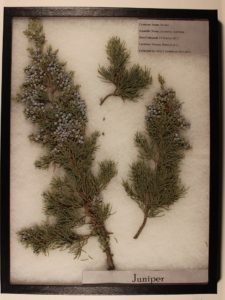| Common Name(s) | Red Cedar, Juniper | ||||
| Scientific Name | Juniperus virginiana | ||||
| Family | Cupressaceae | ||||
| Location/Vegetative Zone | Thicket, Maritime Forest | ||||
| Flowering Period | March-May | ||||
| Identifying Characteristics | Evergreen with fragrant, scaly leaves in shades of green | ||||
Description
- Scale-like leaves
- Pungent, light blue berry-like cones
- Could be as high as 60ft with spire-like canopy
- Plant emits fragrance
- In areas with salt spray, trunks contort and copy flattens
Medicinal/Edible Uses
- Berries
- Can be made into a tea to stop vomiting
- Leaves
- Applied topically to control bleeding
Cultural Uses
- Sold as a type of Christmas tree
- Ornamental
- Lumber used to make furniture
- Wood was once used to make pencils, but has been replaced with cheaper material
- In Native American folklore, cedarwood brought luck and good fortune
Misc
- Serves as cover and nesting site
- Songbirds feed upon cones
- The pungent aroma can serve as an insect repellant
Location
Sources
“All About the Eastern Red Cedar”. National Gardening Association. National Gardening Association. November 23, 2011. Web.
“Eastern Red Cedar”. Natural Resources Conservation Service Plant Database. United States Department of Agriculture. Web.
2,495 total views, 2 views today

